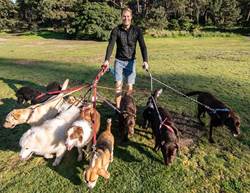Obesity and overweight are important health issues for a troubling number of our furry friends. The most recent surveys of Australian pets has found that 41 per cent of dogs are weighing in well above their healthy weight and 33 per cent of cats are also overweight or obese. It is a disease that kills millions of pets prematurely, can cause complications in almost every system in the body with conditions ranging from diabetes to osteoarthritis, creates immeasurable pain and suffering, and costs pet owners tens of millions of dollars in avoidable medical costs.
“Pet owners and vets both agree that good nutrition can extend a pet’s life. But they differ sharply on what constitutes good nutrition. Pet owners are far more likely to think corn and other grains are problematic,” says Ted Kyle of ConscienHealth. “Many think that food labelled organic and raw diets are better. And yet, none of this is supported by good evidence. In fact, no standards exist for pet foods that claim to be organic. Or ‘holistic’. Or for ‘treats’, (the pet industry’s fastest growing segment).”
All the little extras your dog gets every day can add up to a lot of extra kilojoules and an unbalanced diet if you’re not careful say the veterinarians at Tufts University in the US, who recommend no more than 10 per cent of kilojoules come from foods that are not a dog’s main pet food. Experienced dog owners tend to see them only as a training tool when teaching a dog to walk on a lead or sit etc – a reward for good behaviours and carrying out a command.
A report in Vet Record finds that most commercially available dog treats often exceed the recommended daily energy allowance for treats.
Research led by Giada Morelli at the University of Padua in Italy compared the nutrient composition of different categories of treats to see if the daily intake recommendations on the label were in accordance with the World Small Animal Veterinary Association guidelines.
They analysed 32 popular dog treats available in pet shops and supermarkets (five biscuits, 10 tender treats, three meat-based strips, five rawhides, 12 chewable sticks and six dental care sticks). Three out of four treats contained between four to nine ingredients, and the ingredients were not precisely described. For example, biscuits and dental sticks had ‘cereals’ listed as the first ingredient, while tenders, meat strips, rawhides and chewable sticks had ‘meat and animal derivatives’ listed first.
Almost half mentioned ‘sugars’ on the label’s ingredient list and all contained varying amounts of minerals. Gram for gram the most kilojoule-dense treats were biscuits, whereas the least kilojoule dense were dental sticks.
But taking into account the portion size of individual treats, rawhides were the highest in kilojoules per treat, followed by chewable sticks and dental sticks.
Helping your pet stay lean
The gym may not be an option but there are ways to keep your furry friend slim, according to the Australian Veterinary Association president Dr Paula Parker.
More play time
Being active is just as important to pets as it is to humans. “Consider taking dogs for an extra trip to the park. Get a new frisbee or rubber ball,” Dr Parker says. “Buy your cat a new toy mouse. This provides great exercise for indoor cats and means you can spend time playing together.”
Ration treats
How many treats, and what kind is healthiest for your pet, is something you should chat about with your vet on your next visit.
Size meals right
“Using a measuring device will help to ensure that you are not over-feeding your pet,” Dr Parker says.










